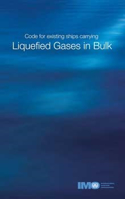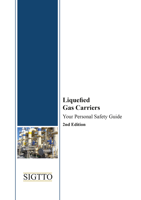Published: June 2022
The publication begins by covering the principal aspects of LPG carrier design, including the cargo containment systems and the equipment on board. It details the basic operation of cargo handling equipment, including key systems such as the cargo pumps, LPG reliquefaction plant, etc.
It then follows a standard LPG cargo sequence, detailing the operations for drying, inerting, gassing-up, cooldown, loading, while on passage and discharging. Text and graphical information is complemented by 3D models, which allow readers to visualise key LPG operations and system layouts. Other operations such as changing tank atmospheres, stenching, mixing cargoes and conducting ship to ship (STS) operations are also explained.
Introduction
Overview of LPG
Section 1 - Equipment and Design
1. Design and Cargo Containment
1.1 Principles of Gas Carrier Design and Construction and The IGC Code
1.2 Liquefied Gas Carriers - Ship Types
1.2.1 Fully pressurised ships
1.2.2 Semi-refrigerated (semi-pressurised)
1.2.3 Fully refrigerated LPG
1.2.4 Ethylene carriers
1.3 General Gas Carrier Layout
1.3.1 General simplified layout of the deck piping on a fully refrigerated LPGC
2. Cargo Handling
2.1 Cargo Piping, Pumping and Valves
2.1.1 Cargo tank piping
2.1.2 Emergency Shutdown (ESD) system
2.1.3 Pressure surge
2.2 Pressure Relief Valves (PRVs)
2.2.1 Pilot operated PRVs
2.2.2 Spring loaded PRVs
2.2.3 Vent arrangements
2.3 Cargo Pumps
2.3.1 Deepwell pumps
2.3.2 Submerged pumps
2.3.3 Booster pumps
2.3.4 Pump performance curves
2.3.5 Running pumps in parallel and in series
2.3.6 Cargo heater
2.3.7 Cargo vaporiser
2.4 LPG Reliquefaction Plant
2.4.1 Reliquefaction plant Single
2.4.2 stage direct cycle Two
2.4.3 stage direct cycle Cascade
2.4.4 direct cycle Cargo
2.4.5 compressors
2.4.6 Compressor suction liquid separator Purge
2.4.7 gas condensor
2.4.8 Typical example of starting a reliquefaction plant (cascade cycle)
2.4.9 Methanol/ethanol injection system
2.5 Inert Gas Systems
2.5.1 Inert gas produced by combustion of gas oil
2.6 Electrical Equipment in Hazardous Areas
2.6.1 Intrinsically safe equipment
2.6.2 Flame-proof (explosion-proof) equipment
2.6.3 Hazardous areas
2.7 Instrumentation
2.7.1 Liquid Level
2.7.2 Float gauges
2.7.3 Capacitance gauge
2.7.4 Ultrasonic gauge
2.7.5 Tank radar gauge
2.7.6 Tank overfill protection
2.7.7 Pressure and temperature monitoring
2.7.8 Vapour detection systems
Section 2 – Initial and In-Service
3. Drying and Inerting
3.1 Drying
3.1.1 Dying methods
3.2 Inerting, Gas Detection and Flammability
3.2.1 Inerting the cargo system
3.2.2 Atmosphere evaluation Fixed
3.2.3 gas detection
3.2.4 Portable gas detection and flammable ranges
3.2.5 Inerting by displacement
3.2.6 Inerting by dilution
4. Gassing-up and Cooldown
4.1 Gassing-up
4.1.1 Gassing up at sea using liquid from deck storage tanks
4.1.2 Gassing-up cargo from the desk storage tanks
4.1.3 Starting the reliquefication plant after gassing-up
4.1.4 Gassing-up alongside
4.2 Cooldown
5. Loading Operations and Loaded Passage
5.1 Prior Loading
5.1.1 Connecting and disconnecting MLAs/hoses
5.2 Loading
5.2.1 Tank filling level
5.2.2 Topping off tanks
5.2.3 Cargo calculations
5.2.4 Operation of the reliquefaction plant
5.2.5 Sampling
5.3 Loaded Passage
6. Discharge Operations and Ballast Passage
6.1 Discharge
6.1.1 Discharge by deepwell or submersible pumps
6.1.2 Discharge using booster pumps and cargo heater
6.1.3 Discharge by vapour pressure
Section 3 Other Operations
7.1 Liquid Freeing (Warming Up/Puddle Heating)
7.2 Inerting
7.3 Aeration
7.4 Purging
7.5 Grade Change
7.5.1 Guidance for when changing from ammonia to LPG
7.5.2 Guidance for when changing from LPG to ammonia
7.5.3 Guidance for changing between butane, butene, butadiene, propane, propene
7.5.4 Guidance for when carrying a previously butadiene cargo
7.5.5 Guidance for changing from butane to propane or vice versa
8. Specialised Cargo
8.1 Odourisation (Stenching)
8.1.1 Method of application
8.1.2 Safety requirements
8.2 Mixing Cargoes (Blending/Co-mingling)
8.2.1 Method of application
8.2.2 Safety requirements and limitations
9. Ship to Ship
9.1 Pre-arrival Stage
9.2 Approach and Mooring Stage
9.3 Cargo Transfer Stage
9.4 Post-transfer Procedure
10. Safety Precautions in LPG
10.1 General Principles
10.2 Terminal and Cargo Operations
10.2.1 Pre-arrival
10.2.2 On arrival
10.2.3 During operations
10.3 Additional Procedures
10.3.1. General operational safety
10.3.2 Other craft and simultaneous operations (SIMOPs)
10.3.3 Protective equipment and protective clothing
10.4 Entry into Enclosed Spaces
Bibliography





































